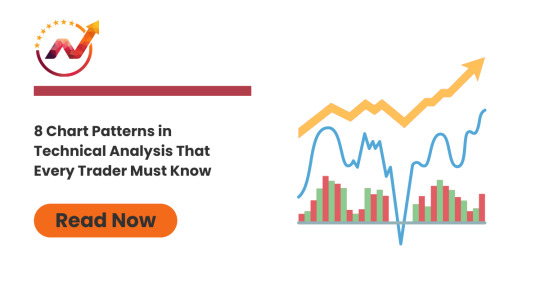#Candlestick Chart
Explore tagged Tumblr posts
Text
Candlestick charts are like storybooks for stock market trends, showing price movements in a simple yet powerful way. This guide breaks down how to read these charts, making it easy for anyone to understand. By the end, readers will feel confident in spotting market patterns and making informed decisions.
0 notes
Text
Understanding Candlestick Charts: A Key Tool for Traders

If you’ve ever looked at a stock trading platform or financial news channel, you’ve probably seen a chart filled with colorful, vertical bars called candlesticks. These aren’t just random decorations—they’re powerful tools for traders to analyze stock movements and make informed decisions. But what exactly are candlestick charts, and how can you use them to improve your trading game? Let’s dive into the world of candlesticks and explore their secrets!
0 notes
Text
Unveiling the Magic of Shooting Star Candlestick Pattern
Title: Unveiling the Magic of Shooting Star Candlestick Pattern: A Step-by-Step Guide Introduction:Candlestick patterns are essential tools for technical analysts in the world of trading. Among the myriad patterns, the Shooting Star stands out as a powerful indicator of potential trend reversals. In this blog post, we will delve into the nuances of the Shooting Star candlestick pattern,…

View On WordPress
#candlestick#candlestick chart#candlestick patterns#candlestick trading#candlestick trading patterns#candlestick trading setup#candlestick trading strategies#candlesticks#candlesticks pattern#elemer of the briar#forex trading against the trend#history of the elder scrolls#japanese candlesticks#making of the elder scrolls#swing trading guide#swing trading patterns#technical analysis chart patterns#the elder scrolls: arena - a complete retrospective
1 note
·
View note
Link
Mastering Stock Market Trend Analysis Charts with Python
This article provides a comprehensive guide to creating insightful stock market trend analysis charts using Python and libraries like yahooquery, talib, and mplfinance. It walks readers through the step-by-step process of setting up the initial configuration, preparing data, outlining the chart structure, rendering candlestick charts, adding moving averages, incorporating MACD indicators and histograms, setting titles, legends, and tick marks, and finally, generating the chart output. By breaking down each step and explaining the underlying code, the article empowers readers to visualize stock trends, moving averages, and crucial MACD indicators, making informed trading decisions based on chart patterns.
The tutorial caters to both beginners and intermediate users, making it an accessible resource for anyone interested in delving into stock market analysis using Python. By covering concepts such as candlestick charting, moving averages, and MACD indicators, the article equips readers with the knowledge and skills needed to create visually appealing and informative stock analysis charts. Whether users are new to coding or have prior experience, this guide provides a comprehensive and detailed walkthrough for implementing trend analysis in the stock market domain.
#Stock market analysis#Candlestick chart#Moving averages#MACD indicators#Data visualization#Technical analysis#Python programming#Financial data analysis#mplfinance
0 notes
Text
The Significance of K-Line Charts in the Financial Industry
Raw Trading Ltd
K-Line charts, also known as candlestick charts, play a significant role in the financial industry as they provide valuable insights into price movements, market sentiment, and potential future trends. Here are some key reasons why K-Line charts are significant:

Visual Representation: K-Line charts offer a visual representation of price movements, making it easier for traders and analysts to interpret and understand market trends. The use of different colors and shapes for the candlesticks helps to quickly identify bullish or bearish signals.
Market Sentiment: K-Line charts reflect market sentiment by showing the balance between buyers and sellers. The color and shape of the candlesticks provide visual cues about the dominance of either buyers or sellers during a specific time period. This information helps traders gauge market sentiment and make informed decisions.
Price Patterns: K-Line charts display various price patterns and formations that can indicate potential trend reversals or continuations. Patterns like doji, hammer, engulfing, and shooting star provide insights into market psychology and can help traders identify potential entry and exit points.
Support and Resistance Levels: K-Line charts help identify key support and resistance levels. These levels represent price levels where the stock has historically encountered buying or selling pressure. Traders use these levels to determine potential entry and exit points and to set stop-loss orders.
Volatility Analysis: K-Line charts provide information about market volatility through the length of the candlestick shadows. Longer shadows indicate higher volatility, while shorter shadows suggest stability. Traders can use this information to assess risk and adjust their trading strategies accordingly.
Confirmation with Technical Indicators: K-Line charts can be used in conjunction with other technical indicators, such as moving averages, trend lines, and oscillators, to confirm or validate trading signals. The combination of K-Line charts with other indicators enhances the accuracy of analysis and decision-making.
Timeframe Flexibility: K-Line charts can be customized to different timeframes, such as daily, weekly, or monthly. This flexibility allows traders to analyze price movements at various levels, from short-term to long-term trends.
Historical Analysis: K-Line charts provide a historical record of price movements, allowing traders to analyze past trends and patterns. By studying historical data, traders can identify recurring patterns and develop strategies based on historical price behavior.
Global Applicability: K-Line charts are widely used across different financial markets, including stocks, currencies, commodities, and indices. This universality makes K-Line charts a common language for traders and analysts worldwide.
Decision-Making Tool: Ultimately, K-Line charts serve as a decision-making tool for traders and investors. By analyzing price patterns, market sentiment, and support/resistance levels, traders can make informed decisions about buying, selling, or holding positions.
In conclusion, K-Line charts are highly significant in the financial industry as they provide a visual representation of price movements, market sentiment, and potential trends. Traders and analysts rely on K-Line charts to identify patterns, support/resistance levels, and market psychology, enabling them to make informed decisions and improve their trading strategies.IC Markets
0 notes
Text
Intuitive Charting Library for Financial Data - DXCharts Lite
DXCharts Lite is an open-source JS library to create interactive real-time and historical charts. Built on HTML5 Canvas for smooth and dynamic chart rendering. Can be helpful for visualizing financial data like stocks, forex, and cryptocurrencies. Table Of Contents Installation Options API Methods How to use it: 1. Import the DXCharts Lite library into your document. <script…

View On WordPress
0 notes
Text


#handmade#resin#candle holders#candlestick holders#yellow green#chart#chartreuse#neon#neon yellow#yellow#uv reactive#uv glow#uv fluorescent#sharkyswaters
3 notes
·
View notes
Text
What is a Candlestick Chart? Understanding the Evening Star Candlestick Pattern
Introduction: What is a Candlestick Chart?
If you're new to Forex or trading in general, you may have come across the term "candlestick chart." But what is a candlestick chart? A candlestick chart is a graphical representation of price movements over a specific period, commonly used in trading to analyze price action. It consists of individual candlesticks, each representing a time period (such as a minute, hour, or day) and showing the open, high, low, and close prices for that period. Candlestick patterns provide valuable insights into market sentiment and can help traders identify potential trend reversals or continuation patterns.

One such pattern is the Evening Star Candlestick Pattern, a crucial formation that traders use to spot potential bearish reversals in an uptrend. In this guide, we will explain what this pattern looks like, how it works, and how you can use it to make informed trading decisions.
What is the Evening Star Candlestick Pattern?
The Evening Star Candlestick Pattern is a three-candle formation that signals a reversal in an uptrend. It's often considered a strong bearish signal, indicating that the market might be ready to change direction. The pattern is made up of the following candles:
First Candle (Bullish Candle): The first candle in the pattern is a large bullish candlestick, signaling that the market is in an uptrend.
Second Candle (Doji or Small Body Candle): The second candle is typically a small-bodied candlestick, often a Doji, indicating indecision in the market. The open and close prices of the second candle are close to each other, signaling a lack of clear direction.
Third Candle (Bearish Candle): The third candle is a large bearish candlestick, closing below the midpoint of the first candle. This confirms the reversal and suggests that the uptrend is losing momentum.
The Evening Star is considered a reliable pattern when it forms at the top of an uptrend, as it signifies that buyers are losing control and that sellers may be taking over.
How to Use the Evening Star Candlestick Pattern in Trading
To effectively use the Evening Star pattern in your trading, it's essential to look for the following criteria:
Uptrend Prior to the Pattern: The Evening Star should occur after a strong uptrend. It is a reversal pattern, so it’s most effective when the market is in a bullish trend.
Confirmation Candle: The third candle, which is bearish, should close below the midpoint of the first bullish candle. This confirms the pattern and the potential for a trend reversal.
Volume: Increased volume during the formation of the bearish candle can add strength to the pattern. A high volume on the third candle suggests a strong bearish momentum.
Advantages of Using the Evening Star Pattern
Predicts Market Reversals: The Evening Star is a reliable pattern for spotting bearish reversals, especially after an uptrend.
Simplicity: The pattern is easy to identify, making it suitable for both beginners and experienced traders.
Effective in Trend Analysis: Combined with other indicators, such as support and resistance levels, the Evening Star pattern can enhance your market analysis and increase the accuracy of your trades.
Conclusion
Understanding what is a candlestick chart and how to read candlestick patterns is essential for any trader. The Evening Star Candlestick Pattern is a powerful tool for identifying potential trend reversals in the market. By recognizing this pattern and understanding its significance, you can better predict market direction and make more informed trading decisions. Whether you're a beginner or an experienced trader, learning to identify and use the Evening Star pattern can enhance your trading strategy and improve your overall success.
#what is a candlestick chart#how to read candlestick chart#how to read a candle chart#what are candlestick charts used for#candlestick chart examples
0 notes
Text
Head and Shoulders Turned Upside Down – A Bullish Reversal Pattern Explained
Charting patterns come in many forms. Some are complex, others straightforward—but all help traders read market movements. One such pattern is the inverted head and shoulders, a powerful signal that a downtrend may be ending.
Inverse Head and Shoulders Pattern
Also known as:
Inverse Head and Shoulders
Reverse Head and Shoulders
Head and Shoulders Inverted
This pattern can appear in forex, stocks, crypto, and commodities.
#Inverse Head and Shoulders Pattern#Technical Analysis Patterns#Candlestick Chart Patterns#Volume Confirmation in Trading#Forex Chart Patterns
0 notes
Text
Fundamentals of Forex Market (₹999)
Start your journey in currency trading with a comprehensive module covering forex basics, market dynamics, key terminology, and chart reading without getting overwhelmed. Ideal for beginners seeking clarity and direction.
#Best Trading App#Best Trading App in India#Trading Course app#Forex and Crypto Trading App#Forex Trading for Beginners#Price Action Trading Strategy#How to Learn Trading#Free Online Trading Courses#Stock Market Trading Courses#Trading On The Stock Market#Financial Markets In India#How to Learn Stock Market Trading#Currency Exchange Trading#Best Forex Trading Platforms in 2024#Price Action Trading#Open a Forex Trading Account#Basic to Advance Trading#Technical Analysis in Forex Trading#Best Technical Indicator for Trading#Basics of Indian Stock Market#Paper Trading Simulator#Bearish Candlestick Patterns#Best Charting Software in India#Smart Money Concepts (SMC)#Objectives of Fundamental Analysis#Financial Markets in India#Bullish Candlestick Patterns#Double Top Chart Pattern#Free Price Action Trading PDF#Ascending Triangle Pattern
1 note
·
View note
Text
Mastering the Three Line Strike Pattern: A Comprehensive Guide to Candlestick Chart Analysis
Candlestick chart patterns play a pivotal role in technical analysis, providing traders and investors with valuable insights into market trends and potential reversals. One such powerful pattern is the Three Line Strike, which can offer valuable signals for decision-making. In this blog post, we’ll delve into the intricacies of the Three Line Strike pattern, exploring its formation,…

View On WordPress
#Bearish Reversal#Bullish Reversal#Candlestick chart#MACD (Moving Average Convergence Divergence)#Market Dynamics#Market Sentiment#Market Trends#moving averages#reversal patterns#Risk Management#RSI (Relative Strength Index)#Stop-Loss Orders#technical analysis#Three Line Strike#Timeframe analysis#trading signals#Trading Strategies#Trend confirmation#Trend Identification#Volume Analysis
0 notes
Text
Nifty Forecast Tomorrow: Expert Predictions and Market Trends You Should Know
If you're looking for the most accurate Nifty forecast for tomorrow, you're not alone. Every day, thousands of traders and investors closely follow the Nifty 50 index, aiming to anticipate the next market move and get a step ahead of the volatility. In this post, we break down key technical levels, current sentiment, and expert-backed strategies to help you prepare for the trading session ahead.
📊 What Is the Nifty 50 and Why Its Forecast Matters
The Nifty 50 is India’s flagship stock market index, representing 50 of the largest and most liquid companies listed on the National Stock Exchange (NSE). It's a key barometer for market trends and investor confidence.
A well-researched forecast for Nifty 50 movement tomorrow can be highly valuable for:
Intraday traders planning entry and exit points.
Swing traders timing short-term opportunities.
Investors staying aligned with macroeconomic trends.
🔍 Nifty 50 Technical Analysis for Tomorrow
1. Key Support and Resistance Levels
Based on today’s market close and recent trading patterns:
Support zones: 22,300 and 22,180
Resistance zones: 22,500 and 22,640
If the index breaks above 22,500 with momentum, it may push higher. A drop below 22,180 could shift sentiment toward bearish.
2. Moving Averages
Nifty is trading above both 20-day and 50-day EMAs, suggesting the trend remains positive.
The Relative Strength Index (RSI) is around 58–60, reflecting healthy momentum without overbought conditions.
3. Candlestick Pattern
Today’s session showed indecision, forming a neutral candle. A breakout candle or a bullish engulfing pattern tomorrow would be a strong confirmation of upward momentum.
🗣️ Market Sentiment & Global Cues
Sentiment in the market remains cautiously optimistic. Some of the key global and domestic factors influencing the Nifty forecast tomorrow include:
U.S. Federal Reserve commentary on interest rates
Movement in crude oil prices
INR/USD exchange rate fluctuations
Institutional investor activity (FII/DII inflow/outflow)
FIIs were net buyers today, a signal that global appetite for Indian equities remains intact — at least for now.
📈 Expert Outlook: Nifty Forecast for Tomorrow
Analysts are leaning towards a mild bullish trend continuing into tomorrow’s session, assuming no sudden negative cues overnight. That said, volatility is likely to spike during the first hour of trade.
Here are some smart trading reminders:
Don’t chase early price gaps.
Stick to well-defined stop losses.
Wait for volume confirmation, especially near breakout zones.
💡 Tip: A breakout above 22,500 on strong volume could provide a high-probability setup for short-term trades.
🛠️ Action Plan for Traders
Intraday Traders
Observe the first 15–30 minute range for market direction.
Indicators like MACD, RSI, and volume spikes are crucial for timing entries.
Use a trailing stop-loss strategy once in profit.
Positional Traders
Consider adding long positions above 22,500 with upside targets around 22,800.
If Nifty dips below 22,180, reassess and wait for a base to form before entering.
🔗 Live Updates and Tools
Want more granular data? For real-time charts, key levels, and analyst videos, check out the full Nifty 50 forecast and live analysis page.
📬 Final Thoughts
A well-informed Nifty prediction for tomorrow helps traders cut through the noise and take calculated risks. No forecast is 100% guaranteed, but combining technical signals, market sentiment, and global cues can give you an edge.
Trade smart. Stay disciplined. And always have a plan.
#nifty forecast tomorrow#nifty 50 prediction#nifty 50 forecast#nifty technical analysis#nifty trend tomorrow#share market forecast#stock market prediction#nifty outlook#nifty analysis#nifty trading strategy#nifty support and resistance#nifty levels tomorrow#intraday trading tips#stock market india#nifty market trend#nifty tomorrow analysis#nifty movement prediction#NSE forecast#indian stock market forecast#market trend analysis#technical analysis nifty 50#nifty 50 chart#fii dii data analysis#stock market update today#trading view nifty#nifty live updates#nifty chart pattern#nifty stock tips#nifty breakout strategy#nifty candlestick analysis
0 notes
Text
Top 8 Must-Know Chart Patterns in Technical Analysis | NTA®
Discover the 8 essential chart patterns every trader should master. Enhance your trading strategy with insights into market trends and price action analysis.

0 notes
Link
Mastering Stock Market Trend Analysis Charts with Python
This article provides a comprehensive guide to creating insightful stock market trend analysis charts using Python and libraries like yahooquery, talib, and mplfinance. It walks readers through the step-by-step process of setting up the initial configuration, preparing data, outlining the chart structure, rendering candlestick charts, adding moving averages, incorporating MACD indicators and histograms, setting titles, legends, and tick marks, and finally, generating the chart output. By breaking down each step and explaining the underlying code, the article empowers readers to visualize stock trends, moving averages, and crucial MACD indicators, making informed trading decisions based on chart patterns.
The tutorial caters to both beginners and intermediate users, making it an accessible resource for anyone interested in delving into stock market analysis using Python. By covering concepts such as candlestick charting, moving averages, and MACD indicators, the article equips readers with the knowledge and skills needed to create visually appealing and informative stock analysis charts. Whether users are new to coding or have prior experience, this guide provides a comprehensive and detailed walkthrough for implementing trend analysis in the stock market domain.
#Stock market analysis#Candlestick chart#Moving averages#MACD indicators#Data visualization#Technical analysis#Python programming#Financial data analysis#mplfinance
0 notes
Text
Unlocking the Power of TradingView: The Best Charting Platform for Traders
A sleek and modern TradingView dashboard displaying real-time charts, candlestick patterns, and powerful technical indicators like RSI and MACD. Are you looking for a powerful, easy-to-use charting tool to enhance your trading? Whether you’re a beginner or an experienced trader, TradingView is one of the best platforms for technical analysis, market insights, and strategy building. And here’s…
#Affiliate Marketing#Automated trading#Candlestick patterns#Crypto trading#Day trading#Forex trading#Investing#MACD#Market analysis#Online trading#passive income#RSI#Stock market#Swing trading#Technical analysis#Trading alerts#Trading bots#Trading platform#Trading signals#Trading strategies#Trading tools#TradingView#TradingView charts#TradingView indicators#TradingView plans#TradingView pricing#TradingView review
0 notes
Text
youtube
Mastering Forex Charts: A Beginner's Guide to Candlesticks, Lines, and Bar Patterns
#Forex trading#Forex charts#candlestick charts#line charts#bar charts#trading tutorial#chart analysis#technical analysis#Forex market#bullish patterns#bearish patterns#price movements#market trends#OHLC#trading strategies#chart reading#price action#trading tips#beginner trading#advanced trading#Forex education#PipInfuse#trading insights#market sentiment#trend analysis#trading confidence#Youtube
1 note
·
View note